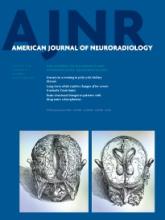Research ArticleNeurointervention
Open Access
Cerebral Aneurysms Treated with Flow-Diverting Stents: Computational Models with Intravascular Blood Flow Measurements
M.R. Levitt, P.M. McGah, A. Aliseda, P.D. Mourad, J.D. Nerva, S.S. Vaidya, R.P. Morton, B.V. Ghodke and L.J. Kim
American Journal of Neuroradiology January 2014, 35 (1) 143-148; DOI: https://doi.org/10.3174/ajnr.A3624
M.R. Levitt
aFrom the Departments of Neurological Surgery (M.R.L., P.D.M., J.D.N., R.P.M., B.V.G., L.J.K.)
P.M. McGah
bMechanical Engineering (P.M.M., A.A.)
A. Aliseda
bMechanical Engineering (P.M.M., A.A.)
P.D. Mourad
aFrom the Departments of Neurological Surgery (M.R.L., P.D.M., J.D.N., R.P.M., B.V.G., L.J.K.)
cApplied Physics Laboratory (P.D.M.)
dBioengineering (P.D.M.)
eRadiology (P.D.M., S.S.V., B.V.G., L.J.K.), University of Washington, Seattle.
J.D. Nerva
aFrom the Departments of Neurological Surgery (M.R.L., P.D.M., J.D.N., R.P.M., B.V.G., L.J.K.)
S.S. Vaidya
eRadiology (P.D.M., S.S.V., B.V.G., L.J.K.), University of Washington, Seattle.
R.P. Morton
aFrom the Departments of Neurological Surgery (M.R.L., P.D.M., J.D.N., R.P.M., B.V.G., L.J.K.)
B.V. Ghodke
aFrom the Departments of Neurological Surgery (M.R.L., P.D.M., J.D.N., R.P.M., B.V.G., L.J.K.)
eRadiology (P.D.M., S.S.V., B.V.G., L.J.K.), University of Washington, Seattle.
L.J. Kim
aFrom the Departments of Neurological Surgery (M.R.L., P.D.M., J.D.N., R.P.M., B.V.G., L.J.K.)
eRadiology (P.D.M., S.S.V., B.V.G., L.J.K.), University of Washington, Seattle.

REFERENCES
- 1.↵
- Lylyk P,
- Miranda C,
- Ceratto R,
- et al
- 2.↵
- 3.↵
- McAuliffe W,
- Wycoco V,
- Rice H,
- et al
- 4.↵
- O'Kelly CJ,
- Spears J,
- Chow M,
- et al
- 5.↵
- Piano M,
- Valvassori L,
- Quilici L,
- et al
- 6.↵
- Yu SC,
- Kwok CK,
- Cheng PW,
- et al
- 7.↵
- Hampton T,
- Walsh D,
- Tolias C,
- et al
- 8.↵
- Velat GJ,
- Fargen KM,
- Lawson MF,
- et al
- 9.↵
- Kulcsar Z,
- Houdart E,
- Bonafe A,
- et al
- 10.↵
- Shojima M,
- Oshima M,
- Takagi K,
- et al
- 11.↵
- Miura Y,
- Ishida F,
- Umeda Y,
- et al
- 12.↵
- Meng H,
- Wang Z,
- Hoi Y,
- et al
- 13.↵
- 14.↵
- Kulcsar Z,
- Augsburger L,
- Reymond P,
- et al
- 15.↵
- Mut F,
- Cebral JR
- 16.↵
- Cebral JR,
- Mut F,
- Raschi M,
- et al
- 17.↵
- Hassan T,
- Ahmed YM,
- Hassan AA
- 18.↵
- 19.↵
- 20.↵
- 21.↵
- 22.↵
- Ferns SP,
- Schneiders JJ,
- Siebes M,
- et al
- 23.↵
- Schneiders JJ,
- Ferns SP,
- van Ooij P,
- et al
- 24.↵
- Chaloupka JC,
- Viñuela F,
- Kimme-Smith C,
- et al
- 25.↵
- 26.↵
- Larrabide I,
- Aguilar ML,
- Morales HG,
- et al
- 27.↵
- Shobayashi Y,
- Tateshima S,
- Kakizaki R,
- et al
- 28.↵
- Schneiders JJ,
- Vanbavel E,
- Majoie CB,
- et al
- 29.↵
- Reymond P,
- Bohraus Y,
- Perren F,
- et al
- 30.↵
- Ford MD,
- Alperin N,
- Lee SH,
- et al
- 31.↵
- Karmonik C,
- Yen C,
- Grossman RG,
- et al
- 32.↵
- Karmonik C,
- Yen C,
- Diaz O,
- et al
- 33.↵
- Melamed E,
- Lavy S,
- Bentin S,
- et al
- 34.↵
- 35.↵
- Hassan T,
- Ezura M,
- Timofeev EV,
- et al
- 36.↵
- 37.↵
- Jou LD,
- Quick CM,
- Young WL,
- et al
- 38.↵
- Boussel L,
- Rayz V,
- Martin A,
- et al
- 39.↵
- Rayz VL,
- Boussel L,
- Acevedo-Bolton G,
- et al
- 40.↵
- 41.↵
- 42.↵
- Ackerstaff RG,
- Suttorp MJ,
- van den Berg JC,
- et al
- 43.↵
- Chang W,
- Landgraf B,
- Johnson KM,
- et al
- 44.↵
- 45.↵
- Waydhas C
- 46.↵
In this issue
American Journal of Neuroradiology
Vol. 35, Issue 1
1 Jan 2014
Advertisement
M.R. Levitt, P.M. McGah, A. Aliseda, P.D. Mourad, J.D. Nerva, S.S. Vaidya, R.P. Morton, B.V. Ghodke, L.J. Kim
Cerebral Aneurysms Treated with Flow-Diverting Stents: Computational Models with Intravascular Blood Flow Measurements
American Journal of Neuroradiology Jan 2014, 35 (1) 143-148; DOI: 10.3174/ajnr.A3624
0 Responses
Cerebral Aneurysms Treated with Flow-Diverting Stents: Computational Models with Intravascular Blood Flow Measurements
M.R. Levitt, P.M. McGah, A. Aliseda, P.D. Mourad, J.D. Nerva, S.S. Vaidya, R.P. Morton, B.V. Ghodke, L.J. Kim
American Journal of Neuroradiology Jan 2014, 35 (1) 143-148; DOI: 10.3174/ajnr.A3624
Jump to section
Related Articles
Cited By...
- Safety and efficacy of coated flow diverters in the treatment of ruptured intracranial aneurysms: a retrospective multicenter study
- Improving Computational Fluid Dynamics Simulations of Coiled Aneurysms Using Finite Element Modeling
- Residence time analysis on cerebral aneurysms treated with coils using planar-laser-induced fluorescence and computational fluid dynamics
- Hemodynamic differences between Pipeline and coil-adjunctive intracranial stents
- Computational fluid dynamics of cerebral aneurysm coiling using high-resolution and high-energy synchrotron X-ray microtomography: comparison with the homogeneous porous medium approach
- Does Arterial Flow Rate Affect the Assessment of Flow-Diverter Stent Performance?
- Endovascular treatment of ophthalmic artery aneurysms: ophthalmic artery patency following flow diversion versus coil embolization
- Determination of a shear rate threshold for thrombus formation in intracranial aneurysms
- Three-dimensional printing of anatomically accurate, patient specific intracranial aneurysm models
- Extra-Aneurysmal Flow Modification Following Pipeline Embolization Device Implantation: Focus on Regional Branches, Perforators, and the Parent Vessel
- Pipeline Embolization Device as primary treatment for blister aneurysms and iatrogenic pseudoaneurysms of the internal carotid artery
This article has not yet been cited by articles in journals that are participating in Crossref Cited-by Linking.
More in this TOC Section
Similar Articles
Advertisement











